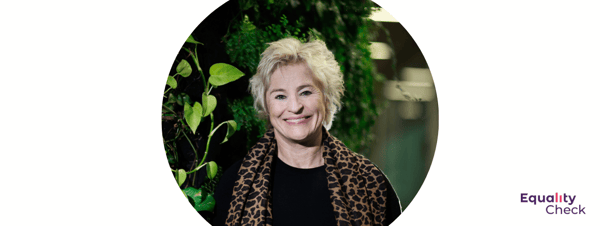The narrative around gender equality has largely shifted in the past few years, and top management is beginning to recognize that gender equality in the workplace isn’t just an admirable goal — it can also drive profitability.
However, we’ve got a long way to go until there is true gender equality in the workplace. Research shows that women are promoted at a slower rate than men, and if the current rate continues the number of women serving in managerial roles will increase by only 1% during the next decade.
However, fixing gender inequality is not just a matter of fighting discrimination. There are systemic issues that organizations must address in order to create a truly equal workplace. We spoke with Britt Nilsen, Head of Sustainability at Schibsted to hear how they are working towards tackling the complex task of putting diversity, inclusion and belonging on top of the agenda.
What is your current ratio of men/women at Schibsted?
We are very pleased to say that we reached the goal set by the Board in December 2017 of a gender ratio of 40:60 in the top three management levels by the end of 2020. Our women proportion by the end of 2020 was 44 percent!
How are you tracking your diversity and inclusion progress?
In the autumn of 2017 with the low rate of females in the management teams after a reorganization and #metoo setting the scene it was necessary to set a goal on the gender ratio. We have been focusing on reaching that goal in the past few years and tracking our progress by measuring regularly. As an example, we are including a description of it and data in our yearly sustainability report.
What has been your diversity and inclusion strategy?
We have worked with different actions the last few years to reach the goal. We updated the recruitment policy and the Talent Acquisition team has operationalized it into their processes. We have had specific goals in Business Areas and separate companies on hiring females. We have also had unconscious bias workshops for managers and recruiters and also for algorithmic bias for product development teams. We established a diversity and inclusion policy as well. It is great to see that all of these actions have led to positive change.
What advice would you give other companies who are trying to improve their ratio?
You need to anchor it in your strategy and have the buy-in from the top. Then set a goal. What we did as a smart move in 2018 was to include reaching short-term goals on gender ratio as part of the incentives for top management. That moved the needle.
How is HR ensuring that they are hiring fairly?
We aim for all recruitments to be fair and transparent, meaning that they should be based on the same objective criteria. Our talent acquisition team has operationalized the recruitment policy into their daily work. The policy is focused on ensuring fair hiring. As an example the policy says that “we should always aim for a representative of both males and females in the recruitment (interviewing) process, to avoid bias decisions”. And also that “all managers in Schibsted should always strive to assemble diverse teams and an inclusive culture. In order to manage gender in this aspect, managers should aim for equality in all pipelines in all recruitment processes”.
How are you planning to proceed from equality to diversity, inclusion, and belonging?
Achieving gender equality is not our end goal. Much more important and much more complex are all the other aspects of diversity, visible and invisible, organizational and social. We have work to do in understanding how to unleash the potential in a diverse workforce, how to include everyone and make sure they feel that they belong in Schibsted. This will be our focus going forward. We will have to give our managers the tools and competencies they need to lead diversity and unleash the potential to create value and innovation.
How are you equipping your managers to lead diverse teams?
We believe it’s about giving our managers competence and tools. I have recently become a certified diversity manager and realized that having a diversity competence is absolutely essential in unleashing the potential in a diverse workforce.
How are you enabling women, LGBTQ, and ethnically diverse employees to build skills for success?
We believe we should enable all employees, regardless of who they are and regardless of any categorization of diversity. We want to ensure that we have a culture in Schibsted where people feel they belong and are included and can be authentic at work. We will do this by raising the knowledge and awareness of diversity, inclusion, and belonging.
Is there anything else you’d like to share?
I would like to end with a quote (not sure who said it first) that I just love, I think it says it all:
Diversity is having a seat at the table. Inclusion is having a voice. Belonging is having that voice be heard.
